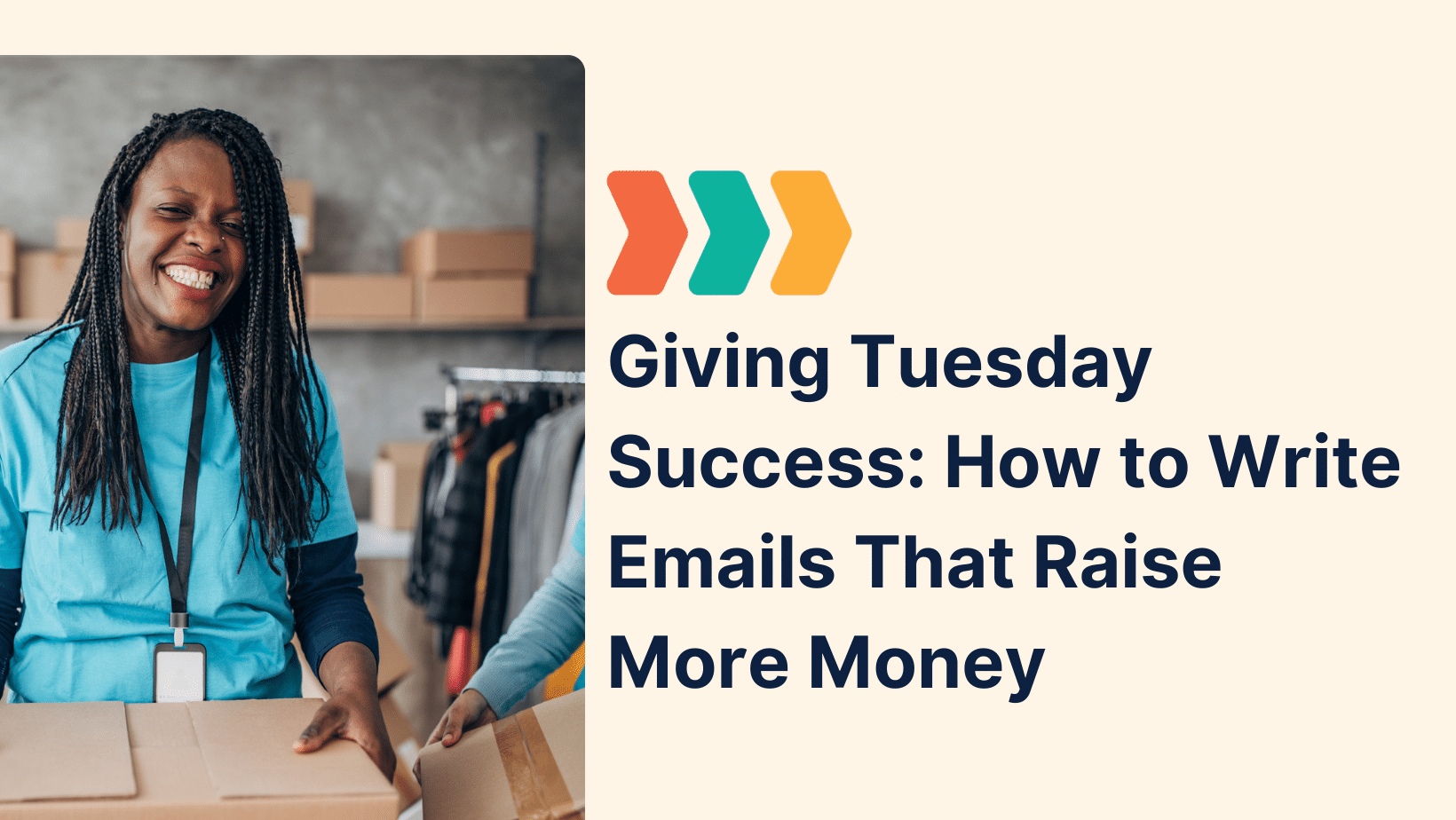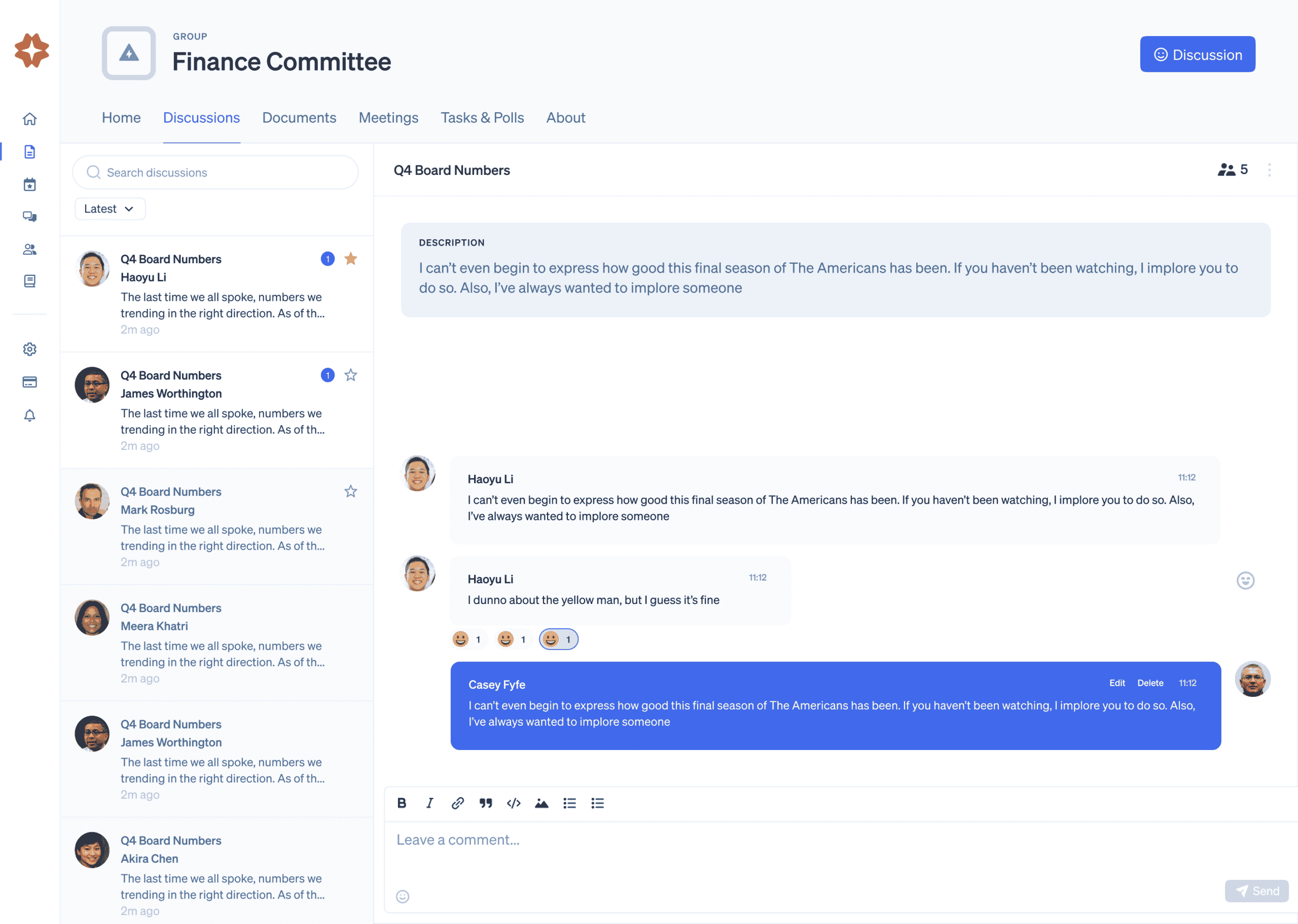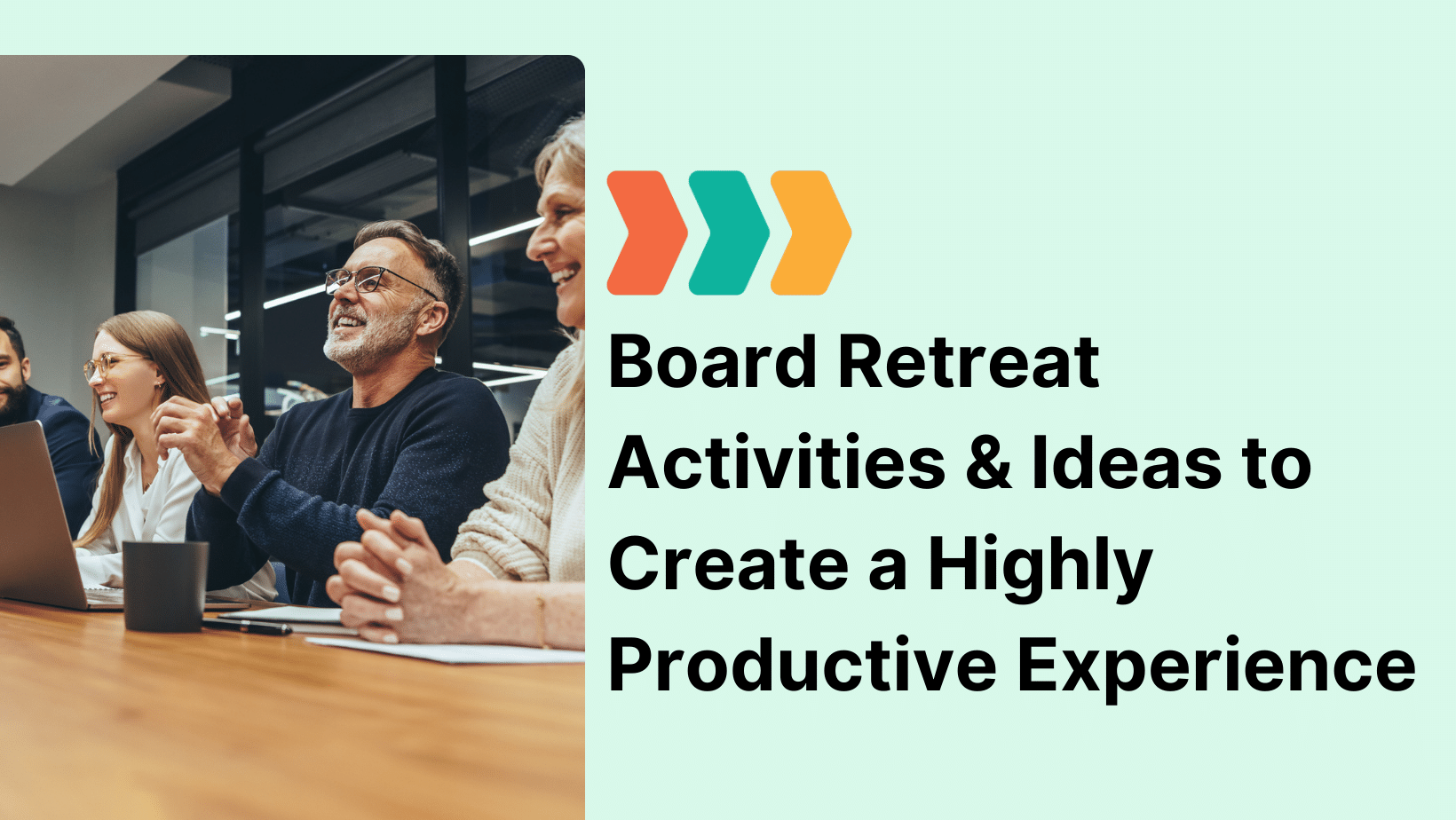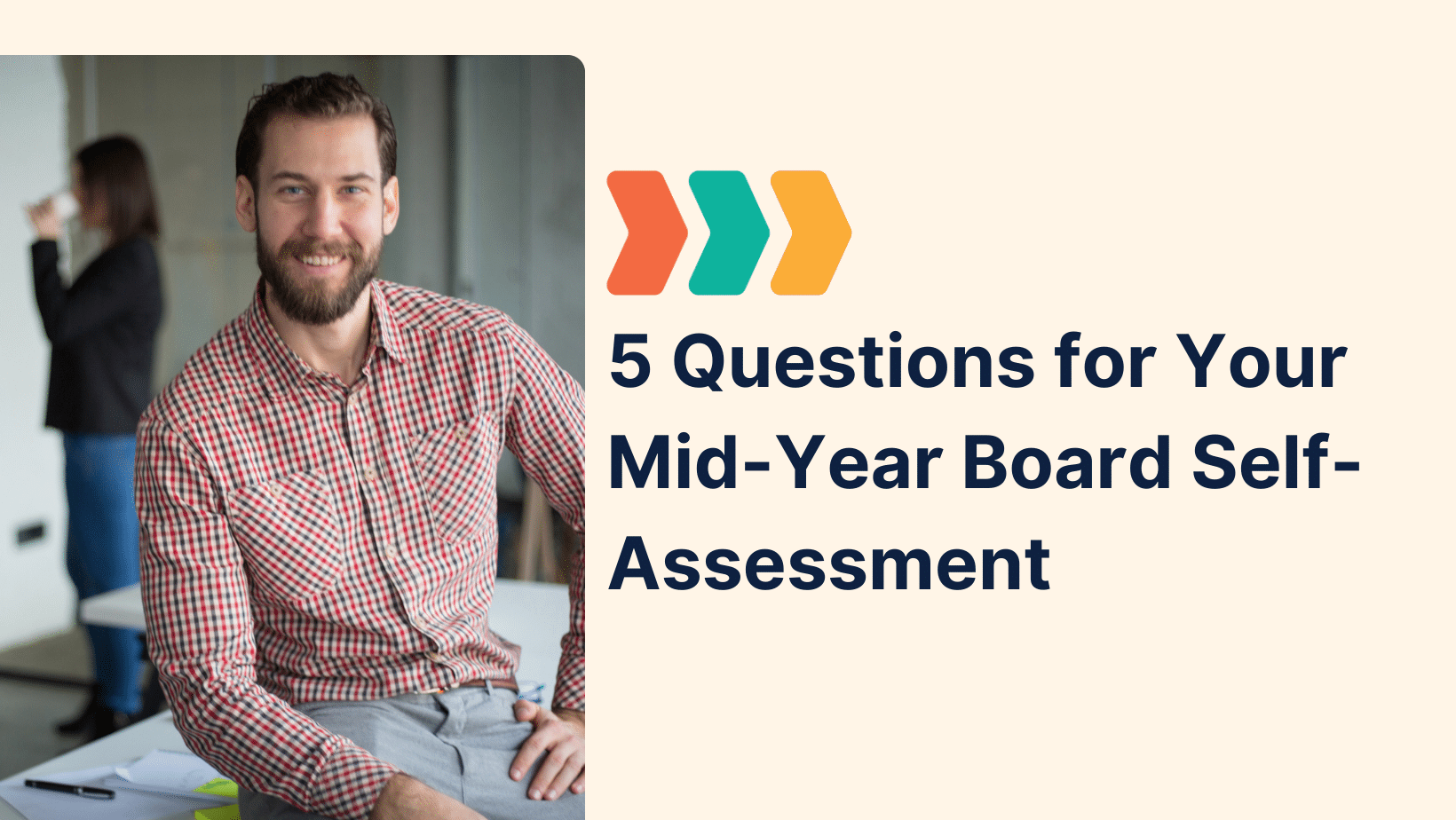Giving Tuesday is a key opportunity for nonprofits to activate their loyal supporters and rally new ones. With Giving Tuesday set for December 3, nonprofits are aiming to raise up to $5.1 billion this year, making it essential to prepare with impactful emails that maximize donations and support your mission.
Recently, in our webinar, Giving Tuesday Success: Writing Emails that Raise More Money, Vanessa Chase Lockshin from The Storytelling Nonprofit joined us to share proven strategies to create compelling emails that drive Giving Tuesday engagement and donations. Here’s a recap tailored for nonprofit executives, admins, and anyone else crafting powerful emails to make the most of your Giving Tuesday.
1. Use Audience Segmentation for more Personalized Messaging
To effectively engage donors, personalize your Giving Tuesday email content by segmenting your audience. This allows you to deliver the right message to the right person at precisely the right time, making your outreach more relevant and impactful. Consider crafting tailored emails based on each recipient’s donation history, level of engagement, or volunteer status—ensuring each email resonates deeply with the reader and increases the chances of a positive response.
- Identify Your Supporters: Begin by categorizing supporters into segments, such as recurring donors, one-time givers, and potential new supporters. Each group has unique interests, motivations, and expectations, so customize your messaging to reflect these differences. For example, recurring donors might appreciate updates on how their contributions have been used, while new supporters may need more context about your organization’s impact.
- Clarify the Goal: For each email, clarify a single, specific call to action (CTA), whether it’s encouraging a donation, a social media share, or volunteer support. Avoid overwhelming readers with multiple CTAs, as this can dilute the main message and encourage inaction from the recipient. By keeping the CTA clear and focused, you guide supporters toward the primary action that will drive the most impact for your Giving Tuesday campaign.
2. Craft Compelling Subject Lines to Capture Attention
Subject lines are critical for grabbing attention and driving higher open rates. In the webinar, Lockshin emphasized that a compelling subject line can make all the difference between an email that’s opened and one that’s ignored. Here are three powerful techniques to ensure your subject lines capture attention and boost engagement:
- Personalize For Impact: Whenever possible, add personal touches such as the recipient’s name or relevant details. This simple step can make the email feel individually crafted, which often leads to higher open rates. For instance, a subject line like, “Emma, Double Your Impact This Giving Tuesday!” can make the recipient feel personally invited to participate, increasing their connection to your cause.
- Emphasize Urgency: Emphasizing time sensitivity can spur quicker responses. Phrases like “Today Only: Help Us Reach Our Goal” create a sense of urgency, motivating readers to open the email immediately rather than letting it sit in their inbox or enter the Trash folder. Urgent language, especially during a campaign like Giving Tuesday, reinforces that this is a special, time-limited opportunity to contribute.
- Keep It Brief and Impactful: A concise subject line—between 6-10 words—strikes the perfect balance, conveying importance without overwhelming the reader. Avoid cluttering the subject with unnecessary words; instead, focus on creating an immediate sense of relevance and intrigue that entices readers to learn more. For example, “Join Us to Make a Difference Today” is both clear and compelling, encouraging recipients to act without overloading them with details.
Using these techniques will help your subject lines stand out in a crowded inbox, likely filled with other Giving Tuesday emails, inviting readers to connect and engage with your message.
3. Use Storytelling as a Core Component
Engaging storytelling is one of the most effective ways to connect supporters to your mission. It humanizes your cause and makes your outreach feel genuine. By sharing specific, real stories of people or communities directly impacted by your work, you create a memorable and emotionally compelling narrative that inspires supporters to take action. Here’s how to maximize storytelling in your Giving Tuesday emails:
- Showcase Real-Life Impact: Highlight personal stories that show exactly how donations have transformed lives or made a difference. A powerful, specific story of someone who benefited from your programs provides a tangible example of your impact. For instance, rather than stating that donations support educational resources, tell the story of a child who was able to attend school or receive necessary supplies thanks to donors’ contributions. Such stories don’t just inform—they inspire action and create a lasting emotional connection.
- Enhance with Visuals: Images, videos, or even GIFs can amplify your story and draw readers in. Visuals bring your stories to life, making the impact you’re describing feel real and immediate. A compelling photo of a community event or a beneficiary enjoying the fruits of your work can communicate more in seconds than paragraphs of text. Visuals should support the story, emphasizing the human aspect of your mission.
- Highlight a Specific, Time-Sensitive Need: To inspire immediate support, clarify exactly what donations will achieve and why it’s essential now. Describe specific initiatives, like “Your gift of 50% will provide meals for 5 families this holiday season,” or “Help us reach our goal to fund 100 new scholarships by year-end”. Defining the impact in clear, measurable terms makes it easier for supporters to see the importance of their contribution. This specificity, especially when connected to a time-sensitive need, boosts urgency and encourages donors to act quickly.
By combining vivid storytelling with relevant, relatable details, your emails will resonate more with supporters, helping them feel like active participants in the journey toward positive change.
If you missed our Storytelling webinar, we recommend checking it out for helpful guidance and practical storytelling tips.
4. Design Clear Calls to Action to Inspire an Immediate Response
Crafting a clear, compelling Call to Action (CTA) is essential for any successful Giving Tuesday email strategy. During the webinar, Vanessa highlighted that a well-placed, concise CTA can significantly increase engagement by guiding supporters toward meaningful actions. here’s how to craft CTAs that align with Giving Tuesday email strategies, inspiring your audience to take immediate action:
- Use Direct, Action-Oriented Language: Your CTA should be straightforward and unambiguous, leaving no question about the action you’re asking supporters to take. Phrases like, “Donate Now to Support [Cause]” or “Join Us to Make a Difference Today” are direct and action-oriented, making it easy for readers to connect with the impact they can have. Avoid vague language. Specificity increases clarity and reinforces the urgency of Giving Tuesday.
- Button CTAs Are Effective: To ensure your CTA doesn’t get lost in the text, use a button format rather than a standard hyperlink. Button CTAs are visually prominent and help draw readers’ attention, making it easier for them to find the action step quickly. Buttons should be simple, using contrasting colors that fit your organization’s branding, with brief, bold text that encourages action, like “Donate Now” or “Give Today”.
- Repeat in Key Locations: Reinforcing your CTA throughout the email can increase conversion rates, as readers may scroll through and revisit content multiple times before acting. Include the CTA at least three times: near the beginning, in the middle, and again at the end of the email. This strategic placement provides multiple opportunities for engagement without feeling repetitive, allowing readers to take action when they’re most inspired.
Implementing these CTA strategies can transform your Giving Tuesday emails, helping readers easily navigate toward making an impact. A clear, well-positioned CTA ultimately simplifies the giving process, empowering supporters to act on their generosity this Giving Tuesday.
5. Build Lasting Connections with Follow-Up and Thank-You Emails
A successful Giving Tuesday email strategy extends beyond the initial day-of campaign. Thoughtful follow-up is crucial for strengthening supporter relationships, maintaining momentum, and demonstrating the impact of each gift. By creating a well-planned series of emails, you can reinforce the connection with your audience and foster long-term loyalty. Here’s how to continue to maximize your post-Giving Tuesday outreach:
- Plan a Series of Emails: An effective Giving Tuesday campaign benefits from multiple touchpoints. Start with a pre-Giving Tuesday email to build anticipation and excitement for the big day. This initial email can introduce the cause, highlight specific goals, and remind supporters to look out for the main message. Follow up with a day-of reminder email that reinforces the importance of immediate participation, encouraging readers to contribute while the momentum is high. Finally, close the campaign with a heartfelt thank-you email that expresses gratitude and begins building a foundation for future engagement.
- Send Timely Thank-You Messages and Impact Updates: Promptly thanking supporters is essential in showing appreciation and validating their contribution. A well-crafted thank-you email, sent shortly after Giving Tuesday, goes beyond generic acknowledgment; it should share specific outcomes and demonstrate the immediate impact of their donation. For instance, include details like total funds raised or initial plans for utilizing the contributions. Bonus points if you follow up later with further updates, such as a short story or visuals showing donations that have positively affected your cause. These updates reinforce the value of their gift and encourage supporters to stay engaged with your mission for the long term.
By keeping supporters informed and appreciated beyond Giving Tuesday, your organization can build lasting relationships that go well into the future, turning one-time donors into long-term advocates for your cause.
6. Optimize Giving Tuesday Email Strategy Success with Testing and Performance Analysis
To ensure your Giving Tuesday email campaigns remain effective and engaging, it’s essential to measure their impact and explore new approaches. As emphasized on the webinar, continually analyzing performance data and conducting tests can uncover valuable insights to refine future campaigns. Here are some key steps to help improve your strategy:
- Run A/B Tests on Subject Lines: Subject lines are the first interaction recipients have with your email, making them essential to ensure your emails get opened. Conduct A/B tests on different subject line variations to identify which style resonates most with your audience. Try testing elements such as personalization, urgency, and curiosity. Experimenting with word count, tone, and even the inclusion of emojis can also reveal preferences, helping you refine your approach based on data rather than guesswork.
- Evaluate Key Metrics: Analyzing open rates, click-through rates, and conversions can reveal which emails perform best.
- Request Feedback When Possible: Surveying a small segment of supporters after Giving Tuesday can provide valuable insights for refining your next campaign.
Giving Tuesday Email Examples to Inspire Your Campaigns
Looking for inspiration? Here are a few Giving Tuesday email examples that illustrate effective strategies in action.
In one example, a nonprofit uses heartfelt storytelling paired with a personal appeal to connect with readers on an emotional level. The subject line, “How Your Gift Can Change Lives This Giving Tuesday,” immediately signals the impact supporters can make, drawing them in with curiosity and compassion. The email opens with a short story of a community member directly impacted by the nonprofit’s work, accompanied by a powerful image that brings the narrative to life. Throughout the email, the call to action (CTA) “Give Today” appears prominently, encouraging supporters to take immediate action and feel they’re directly contributing to meaningful change.
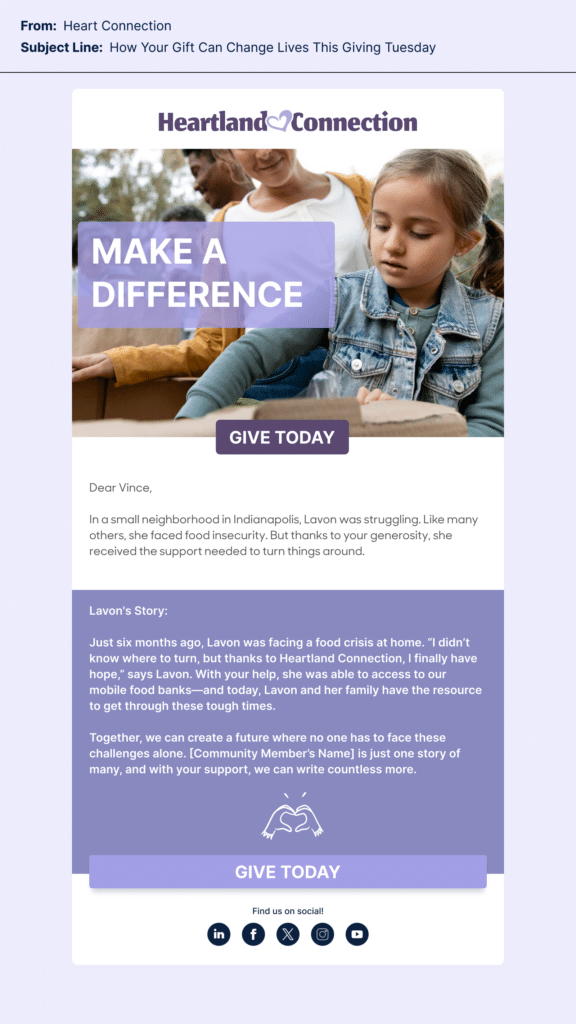
Another approach emphasizes urgency to drive quick action. With a subject line reading, “24 Hours Left to Make a Difference,” this email creates a sense of time sensitivity that motivates readers to respond right away. Using concise, action-oriented language, the email highlights the limited time left to contribute, while a visually distinct CTA button reinforces the message and leads readers straight to the donation page. This approach is particularly effective for campaigns that rely on the momentum of a short-term, high-impact day like Giving Tuesday.
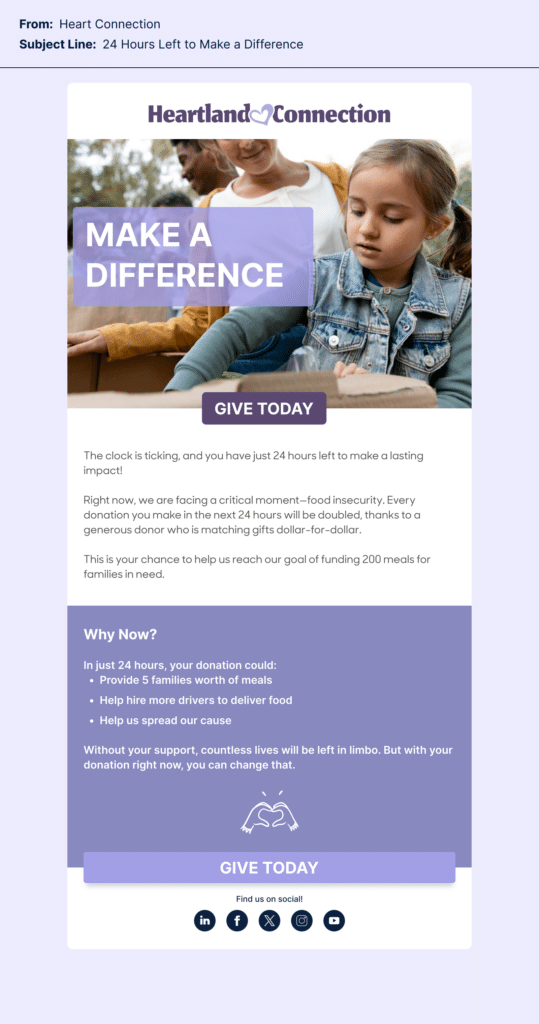
In a third Giving Tuesday email example, a nonprofit combines the power of community with multichannel engagement to broaden its reach. The subject line, “Help Us Reach Our Giving Tuesday Goal!” invites recipients to take part in something larger, encouraging them not only to donate but also to share the campaign across social media. The email includes a secondary CTA button specifically for social sharing, expanding the campaign’s reach beyond email and inviting supporters to amplify the mission by spreading the word within their own networks. This approach not only drives donations but also builds broader awareness and potentially attracts new donors who resonate with the cause.
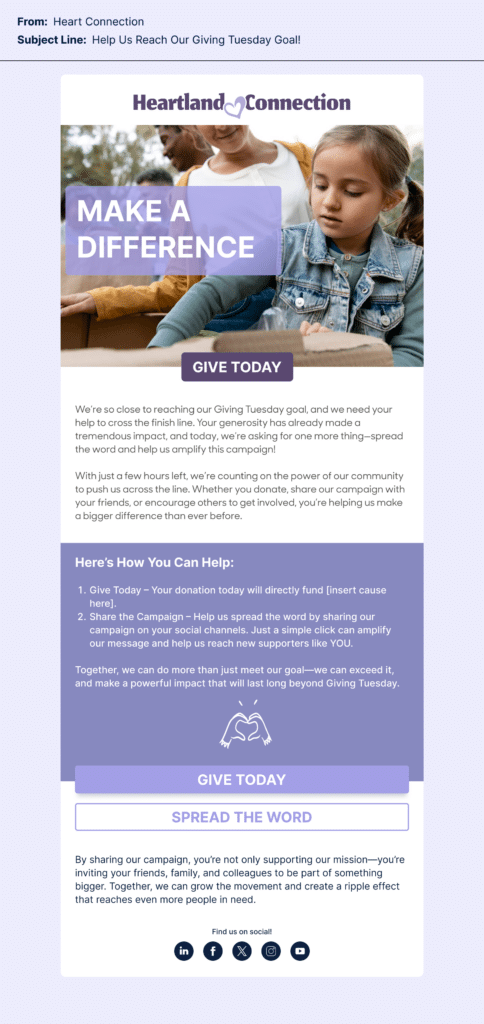
Each of these Giving Tuesday email examples demonstrates how different strategies—storytelling, urgency, and multichannel sharing—can be tailored to create a compelling Giving Tuesday email series. By incorporating these elements into your campaign, you can engage supporters, drive donations, and inspire others to join your mission, ultimately making a greater impact on this special day.
Giving Tuesday is an ideal time to build strong connections with your supporters. With the email strategies from our webinar—focusing on personalized messaging, impactful storytelling, and well-crafted CTAs—your nonprofit can make the most of this powerful day of giving. These emails can mobilize your community, strengthen your mission, and create lasting change. For more actionable insights on email marketing and fundraising, check out the Boardable blog.
